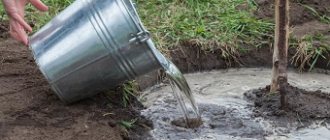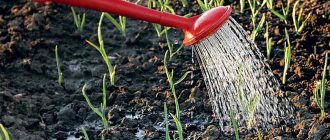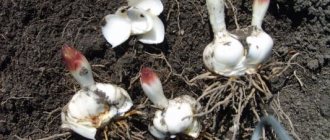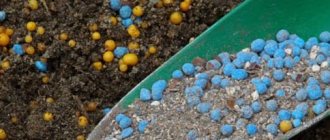Lilies are loved by many women for their fantastically beautiful blooms.
Flower growers often grow these plants wanting to get lush, fragrant inflorescences. In order for lilies to bloom profusely and magnificently, they need help. This can be done using a variety of fertilizers. We will talk about them in our article today. Dear readers! For you, we have created communities on social networks in which useful articles and interesting ideas are published several times a day! Subscribe and receive useful content in a convenient format!
When to feed lilies in spring
The first time nutrient mixtures for the plant can be applied at the soil preparation stage. At this point, it is best to use organic matter. But this is an optional supplement. If you have good soil, then it is not necessary to fertilize it.
ON A NOTE. You can also fertilize in the snow. When the snowdrifts begin to actively melt, simply scatter urea over their surface (2 spoons per square meter).
The next feeding is carried out at the budding phase. At this time, it is better to use complex preparations (for example, nitroammofoska, mullein infusion).
Two more planned feedings are carried out in summer and autumn.
How to determine micronutrient deficiencies in flowers
Micronutrient deficiency in a given plant is determined by its appearance.
- If the leaves become pale, and some even turn yellow, then the plant does not have enough nitrogen.
- When growth and bud formation are delayed, potassium deficiency is determined.
- A lack of phosphorus also manifests itself in delayed development, but in addition, the leaf blades begin to dry out.
- Deformation and falling leaves indicate a lack of calcium.
- Magnesium deficiency manifests itself in the idea of lily leaves turning pale and curling.
How to water lilies in open ground
Another important question that interests many gardeners is how often to water lilies?
In the wild, these flowers grow in places where the soil is covered with foliage, which does not allow moisture to evaporate quickly. Therefore, lilies are accustomed to water and are moisture-loving plants. Therefore, these flowers need regular watering. However, you need to be careful to prevent water stagnation, since excessive moisture will also not benefit the plant. The bulb of the flower may begin to rot. The risks of botrytis and fungal diseases also increase.
But don’t be afraid - everything will definitely work out if you adhere to the following watering rules:
- In the absence of rain, lilies need to be watered approximately once a week. It all depends on the type of soil: sandy loam is irrigated more often, and clayey soil less often.
- Water is poured onto the flower only at the root.
- The appropriate time of day is the first half of the day, namely before 13:00. This is necessary so that the top layer has time to dry before the night when it gets colder.
- You should be especially careful with watering in the spring, since frost can return at this time, and cold nights can also be dangerous.
- Spring watering is carried out in conjunction with growth stimulants and anti-stress drugs.
- Lilies need water most from June to August - during the hottest months, as well as after flowering, when the bulbs are forming and the plant needs to stock up on nutrients before winter sets in.
Stop watering in the fall, when the lilies fade and preparations for the winter period begin. Of course, if we are not talking about a hot climate, when the soil is very dry. In such conditions, the flower can be watered 2 more times until the leaves completely turn yellow.
This is interesting: How to grow an apricot from a seed - step-by-step instructions
Schemes for feeding lilies with fertilizers
Let's consider the traditional scheme of feeding this plant for lush flowering.
Ammonium nitrate
This product is applied in early spring (you can even sprinkle it on the snow).
Nitrophoska
As soon as the first very small shoots appear, you need to apply complex fertilizer. It is better to use nitrophoska. You need 20 grams for every square meter of area. Please note that you first need to moisten the soil under the plants, and only then pour the nutrient mixture.
The second time nitrophoska can be added during the active formation of buds. We increase the dose by 2 times to 40 g per square meter. In terms of applying the liquid composition – 40 grams per bucket of water, 0.5 liters for each flower.
Potassium humate
They can replace nitrophoska at the beginning of flowering. Recipe for preparing top dressing: 50 ml of humate per bucket of water.
Superphosphate
This mineral fertilizer is applied when flowering begins. The product is diluted in water (10 g per bucket) and used for watering.
Calimagnesia
This is an alternative to superphosphate. The product can also be used at the beginning of flowering and after it ends. The form of fertilizer is liquid. You need 15 grams of potassium magnesia per bucket of water.
Autumn feeding
In September, active preparations for winter begin on all land plots. But if the soil without the presence of main crops is easier to prepare, then perennial plants, especially flowers, require care.
Rules and special instructions
Closer to September, the bulbs begin to prepare for winter. In other words, they move from the phase of active growth and development to the resting stage. Nitrogen and potassium substances will help ensure restful sleep. Immediately after flowering, potassium sulfate and superphosphate are added.
The best protection for oriental lilies, as well as water lilies during heavy rains, is spraying with Bordeaux mixture. This autumn procedure additionally becomes a disease prevention.
To enrich the soil and protect it from frost, use mulch from rotted compost or leaf humus.
To make lilies feel protected in winter, follow the following rules:
- The main manipulations should take place after flowering. Only complex mixtures are added warm. The calculation of a standard diluted substance (5 liters of water + superphosphate, 1 tsp of potassium salt) is carried out by unit. One lily requires half a liter of solution.
- In the fall, potassium and phosphorus will be the best helpers for the gardener in care.
- The procedures are planned in early September. Otherwise, the lilies produce young shoots.
- It is forbidden to apply nitrogen in the autumn.
What to feed during planting
You can lay the foundations for future flowering at the stage of spring planting the bulbs in the soil. At this time, you can add a mixture of rotted compost or manure and double superphosphate. The rate of incorporation of fertilizer into the soil is 7 kg of organic matter and 100 grams of superphosphate per square meter.
Alternatively, you can use wood ash or ashes. The consumption rate is much less, and the efficiency is no lower. For every square meter of the future flower garden, add 100 grams of ash.
ON A NOTE. If your site has fertile soils rich in mineral microelements and organic matter, then planting fertilizing may not be necessary.
Recommendations from experienced gardeners
If the soil is fertile or has already been fertilized with complex preparations, it is not necessary to feed the lilies during the first year or two. Otherwise, it is recommended to adhere to the following feeding scheme:
- when the sprouts rise 15 cm, water the soil with a solution of calcium nitrate, repeat after 10 days;
- before the beginning of abundant flowering, use “Kemira Lux”;
- During the budding period, use potassium magnesium to make the flowers brighter.
Adherents of home fertilizing methods fertilize flower beds with yeast, chicken droppings, and wood ash. Lilies respond especially well to the latter; the bulbs become large and healthy. It is applied several times throughout the season. Folk remedies are used in parallel with agrochemicals, and not instead of them. Timely application of suitable fertilizers will support lilies at all stages of development and help resist pests and diseases.
Feeding lilies with folk remedies
You can also feed lilies using folk remedies. There are, however, very few of them, and they are used as an aid.
Ammonia
Ammonia saturates lilies with nitrogen. You only need a teaspoon of the drug per liter of water.
Onion peel
Onion peels are used when planting, mixed with soil at the bottom of the compost pit.
What should you not fertilize lilies with?
Now let's talk about those fertilizers that are prohibited to use.
First of all, it is fresh manure. In this case, the lily is no different from any other plants. Fresh organic matter will only cause harm, so the manure must rot.
Next, it is worth remembering that lilies cannot be fed with highly concentrated solutions. It is optimal to apply fertilizer in several doses.
Also, you cannot fertilize lilies using foliar fertilizers using organic matter and mineral fertilizers.
Common mistakes
- Using fresh humus or manure. Like other plants, lily does not tolerate the addition of fresh organic matter. The manure must rot.
- Spraying with urea and other fertilizers. Foliar feeding can only be done with ammonia solution (in the early stages) and special means (for example, Stimul).
- Applying fertilizers to dry soil. Before adding liquid nutrients, the soil under the lilies must be shed with water.
- Using dry fertilizers without further watering. If you scatter granules over a flower garden, do not forget to water them generously, since mineral fertilizers do not decompose without liquid.
Replanting lilies after flowering
Lilies can grow in the same place for no more than 5 years. Next, they need to be replanted, otherwise the plants will begin to degenerate and the flowers will become smaller. It is also worth taking into account the growth of mother bulbs, around which children manage to form in a few years; they must be replanted.
Lilies are replanted in the fall. At this time, the bulbs adapt better to the new site, and there is no need to store them. The exact timing of transplantation depends on the climate. In the Moscow region, it is advisable to carry out planting work in August-September. In regions with milder conditions, lilies are moved later, closer to October.
Soil selection
The quality of lily flowering is determined by the soil composition. Before planting lilies, the soil at the planting site is carefully dug up, making it loose and breathable. Stagnation of moisture is unacceptable, otherwise the bulbs will simply rot. To facilitate moisture removal, peat and river sand are usually added to the soil.
Important! Before preparing a soil mixture for lilies, it is advisable to familiarize yourself with the varietal characteristics of a particular plant.
Feeding during transplantation
The soil under the flowerbed with lilies is dug up in advance, adding superphosphate and potassium sulfate. If deoxidation of the soil is necessary, then chalk, lime or dolomite flour must be added.
Applying fertilizers during transplantation will allow plants to develop normally.
Lilies are no more demanding than other flowering crops. Having taken up the task of growing them in the garden, the gardener must provide complete care and promptly apply the necessary fertilizing. By adhering to the above rules, you can get luxurious, abundantly and brightly flowering lily bushes.
Answers to frequently asked questions
Why feed lilies in the spring?
To improve flower growth, ensure long-term flowering and increase immunity and disease resistance.
What is better organic or mineral fertilizers?
It is best to combine them, adding them one by one.
How many times do you need to feed flowers?
The standard feeding scheme includes 4 applications of fertilizers: in early spring, at the budding stage, at the beginning of flowering and after flowering. Other feedings are carried out in case of a lack of any element or plant disease.
Rules for applying fertilizers
Regardless of the variety grown, fertilizer for lilies in spring and summer is simply necessary. Perennials respond well to care, but you should not get carried away with fertilizing. Liquid preparations are better absorbed, but those used in excess can burn the roots. Dry compounds with a moisture deficiency do not dissolve well in the soil, therefore, when using them, the soil should be well moistened.
An important nuance: for 2 years after planting in fertile soil, you don’t have to worry about what to feed the lilies for abundant flowering, since the soil already contains enough nutrients. Feeding plants during this period will cause the bulbs to grow and the inflorescences to become smaller.










